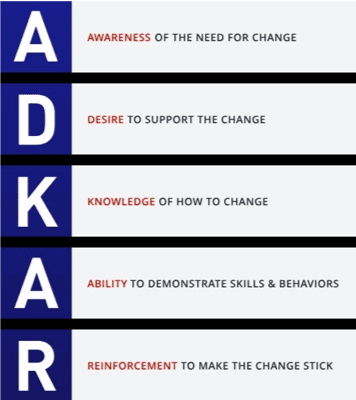Anytime an enterprise embarks on an initiative or takes up a new project to optimize its performance, address salient issues or seize opportunities; it usually requires changes. These changes could affect its processes, organizational structures and types, job roles, and how technology is utilized.
But, what is change management? It is a discipline that provides oversight on how to prepare, empower, and support employees to successfully embrace and adopt a change to achieve organizational outcomes or success. For further change management definitions, check out our Glossary What is Change Management .
.
Nevertheless, the onus for change rests on the employees. They are the ones who need to adjust to how they perform their roles and responsibilities. If the change fails to happen at the individual level, transitions at the corporate levels become unmanageable. The maximum result can only be guaranteed when workers embrace and adopt transitions needed by the project or initiative.
Although every change is unique, as well as each employee, a lot of studies have indicated several procedures that can be taken to influence employees during their transitions. A structured methodology is provided by change management in supporting them to transition from their present states to the aspired or expected states.
What are the Three Levels of Change Management?
Personal or Individual Change Management
It is natural, physiological as well as psychological for humans to resist change due to our resilience. Nevertheless, we are bound to embrace differences and successfully adapt to a new way of doing things.
Managing change at the individual level demands knowing how change affects individuals and how they deal with it. There is a need also to understand what can help them achieve a remarkable transition: what verbal cues or messages they need to hear when they need to listen to it, and from whom? When is the best time to provide skill development, coach individuals to behave expectedly, and what makes transitions permanent? Disciplines like neuroscience and psychology are drawn on at the individual change management level to apply workable systems to individual change.
Prosci, having studied how individuals experience is shaped during transition for years, came up with the ADKAR Model. We would look at this model later.
Organizational Change Management
Change becomes challenging to be managed by a project team on a personal basis as long has it has occurred at the individual level. Organizational, also called initiative change, exposes us to the guides and actions to implement at the initiative level to empower and support a lot of individuals impacted by the project or initiative.
It involves identifying the people and groups that will require change as a result of the initiative, in what magnitude they will need it. It consists of designing a unique plan to ensure affected employees have the awareness, coaching, leadership, and training required to transition successfully. The focal point in managing change at the initiative or organizational level should be to drive a successful individual change.
Organizational change management complements project management. While project management ensures the designing, developing, and delivery of the project’s deliverables or outcomes, organizational change management ensures the proper embracement and adoption of the project’s outcome.
Enterprise Change Management
This is a core competency of an enterprise that creates competitive differentiation and the capability to adapt effectively to the ever-changing market. Change management at the enterprise level means incorporating effective change management into its roles, structures, systems, processes, initiatives, and leadership capabilities. The procedures are applied consistently, as well as effectively to the projects. Corporate leaders can guide the teams throughout change while the employees are conversant with what to request to be successful.
capabilities. The procedures are applied consistently, as well as effectively to the projects. Corporate leaders can guide the teams throughout change while the employees are conversant with what to request to be successful.
The end goal of managing change at the enterprise level is that organizations can respond very fast to changes in the market, welcome strategic moves, and adopt a new approach and technology with less productivity impact. This capability does not occur by chance; it is a deliberate and strategic method to incorporate change throughout the organization.
Other Important Approaches and Models of Change Management
Do you intend managing change and implementing its strategies, it is essential to prevent establishing unimportant or random approaches and only channel energy towards the best action plan. Change management is a continuum. All hands must be engaged to make change happen- individuals and those affected by the change.
Before you adopt any model or approach, you might need to figure out why your business needs change and how the change will impact it.
Best in Class Approaches and Strategies to Establish Change Management
1. ADKAR Model

This change theory is goal-oriented. It enables management teams to channel energy towards actions, steps, and endeavors that complement the goals or outcomes it desires to actualize. The purposes defined and derived outcomes utilizing the model are sequential and cumulative. An individual needs to get each end or results in a specific ordered way to enable the sustainability of the change. Change managers can adopt this model to discover many gaps in the change process and suitable fashion training for employees.
Some of the uses of this model include:
1. Providing assistance and support to workers in going through transitioning during the change management.
2. Diagnosing and providing solutions to the resistance employees showed during change.
3. Devising a workable and efficient plan for the executives and personal development throughout the change.
What does ADKAR stand for:
Awareness– of both need and requirements for change to occur.
Desire– to facilitate change and be an active part of it.
Knowledge- of how to make change happen.
Ability– to make change a continuum
Reinforcement– to ensure it is implemented and also reinforced subsequently.
Importance of the ADKAR Model
1. It provides the ability to identify and evaluate the rationale behind the reasons why changes don’t work, and the expected outcomes are not being realized.
2. It simplifies breaking changes into many sections and identifying the exact point where the effect of change may not be felt as planned.
3. It provides both business and people dimension of change.
2. McKinsey 7 S Model

The 7 S model by McKinsey is one of the notable models that had remained relevant even when other models became obsolete. The model was designed by McKinsey & Company’s consultants in 1980 and had seven stages in managing change.
Steps
1. Strategy: This is the plan designed to outperform competition and attain goals. It is the first step of transition based on the McKinsey’s 7-S design, and it demands the designing of a plan or a step-by-step method.
2. Structure: This is the model attribute that relates to the division of the enterprise or the structure it follows.
3. Systems: It refers to how daily activities are carried out.
4. Shared values: This is the core values that guide its operations and activities.
5. Style: This is how leadership and changes are implemented.
6. Staff: This is the workforce and its corporate capabilities.
7. Skills: It refers to the capabilities and competencies possessed by the organization’s workforce.
Pros
1. It provides steps and approaches to understand an enterprise and gain a more in-depth insight into how it works.
2.The model factors in the emotional and practical aspects that are crucial in creating means that help employees handle transitions easily.
3. It also considers all components as essential and worth considering and does not isolate other aspects that may be beneficial.
Cons
1. The interdependence and interrelationship of all factors can cause the model to fail if an aspect fails. This is the greatest consequence of this model.
2. It is a complex model compared to others, and it does not focus on differences.
3. Many organizations that have adopted this model have encountered failures, and this can be regarded as a significant dent associated with the model.
3. Nudge Theory

This is a concept that has gain mainstream in economics, behavioral science, and political theory. It is applicable to change management in businesses and organizations. The theory is credited to Richard H. Thaler and Cass R. Sunstein. Nudging or encouraging someone to change is the main essence of the theory. The Theory is helpful in both exploring dominant influences and explaining to them to alter or remove them to a point where positives can be derived.
It is essential to know many slight nudges exist which can be accidental or deliberate. This theory seeks to understand diverse influences on the behavior in a bid to change people. Preferences must be designed to align with how people think and make decisions.
The theory is sophisticated in its approach and differs from other models as far as change is concerned. It removes the conventional change techniques such as direct instructions and punishment reinforcement.
A significant benefit of this model is that it factors in the differences in emotions, opinions, and personal knowledge and considers the reality of the circumstances. It also looks at the features of human behavior and nature. It reduces resistance from the company’s employees and is applicable in many industries.
You can read other models of Change Management in this article titled, “What is Change Management and Why It is Essential For Digital Transformation.”
It is ideal for identifying change management objectives and suitable models to make it happen. There may be resistance as you facilitate change on all levels as a corporate leader, but the effects could be lasting.
Related Questions
What are The Levels of Management? Changes can occur at the personal or individual level, organizational, and enterprise level. Quick response to changes is essential across all levels.
What is the best change management model? The best model will look at the individual differences, reduce resistance to change, and must be applicable across industries like Nudge Theory and others.


